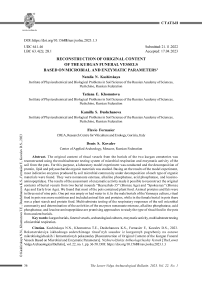Reconstruction of original content of the kurgan funeral vessels based on microbial and enzymatic parameters
Автор: Kashirskaya N.N., Khomutova T.E., Dushchanova K.S., Fornasier F., Kovalev D.S.
Журнал: Нижневолжский археологический вестник @nav-jvolsu
Рубрика: Статьи
Статья в выпуске: 1 т.22, 2023 года.
Бесплатный доступ
The original content of ritual vessels from the burials of the two kurgan cemeteries was reconstructed using the multisubstrate testing system of microbial respiration and enzymatic activity of the soil from the pots. For this purpose, a laboratory model experiment was conducted and the decomposition of protein, lipid and polysaccharide organic materials was studied. Basing on the results of the model experiment, most indicative enzymes produced by soil microbial community under decomposition of each type of organic materials were found. They were nonanoate esterase, alkaline phosphatase, acid phosphatase, and leucine- aminopeptidase. The results of the assessment of enzymatic activity made it possible to reconstruct the original contents of burial vessels from two burial mounds “Beysuzhek-35” (Bronze Age) and “Spokoynyy” (Bronze Age and Early Iron Age). We found that most of the pots contained plant food. Animal proteins and fats were in three out of nine pots. One pot was empty or had water in it. In the male burials of the Yamnaya culture, ritual food in pots was more nutritious and included animal fats and proteins, while in the female burial in pots there was a plant starch and protein food. Multisubstrate testing of the respiratory responses of the soil microbial community and determination of the activities of the enzymes nonanoate esterase, alkaline phosphatase, acid phosphatase, and leucine-aminopeptidase are promising approaches to study the type of ritual food in the pots from ancient burials.
Короткий адрес: https://sciup.org/149143234
IDR: 149143234 | DOI: 10.15688/nav.jvolsu.2023.1.3


